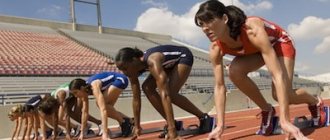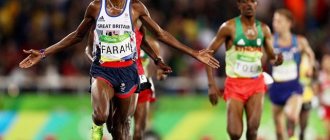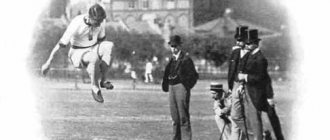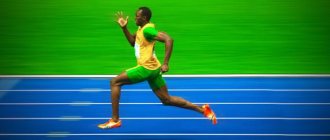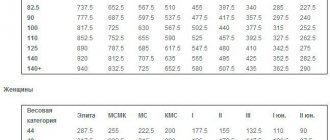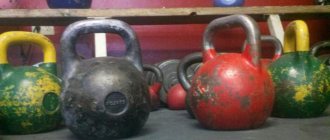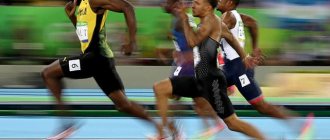Sprint running, the technique of which has been developed over years, belongs to the category of athletics. Running 100 meters is a technique for drawing up certain tactics to improve performance. This is facilitated by physical and moral training so that the athlete’s results meet accepted standards. After the new athlete has mastered the intricacies of running and developed certain tactics, they work to improve the result. His goal is to keep his body in shape and achieve superiority in the standards.
The 100-meter run exercise, which develops speed, endurance, and concentration, allows the athlete to achieve results. Training helps the body get used to heavy loads and protects the heart from the consequences of overload. To keep a sprinter's body in shape, they train regularly.
Odnoklassniki
World records in the 100 meter dash
The world record for the men's 100m is held by Jamaican runner Usain Bolt, who completed the distance in 2009 in 9.58 seconds, breaking not only the distance record, but also the human speed record.
The world record in the men's 4x100 meter relay also belongs to the Jamaican quartet, which covered the distance in 36.84 seconds in 2012.
The world record in the women's 100 meters is held by American runner Florence Griffith-Joyner, who set her achievement in 1988, running 100 meters in 10.49 seconds.
The world record in the women's 4x100 meter relay belongs to the American quartet, which covered the distance in 40.82 seconds in 2012.
One hundred meter running technique
Each of the sprint distances includes 4 stages from start to finish:
- Start
- Starting acceleration
- Distance running
- Finishing
Success is guaranteed to the athlete who perfectly completes each of the four stages. But in modern sprint there has never been such an athlete. Even the king of short distances, Usain Bolt, often loses to his opponents in the first 2 stages.
Biomechanics specialists attribute Bolt’s unsuccessful starts to his height, which exceeds the norm by 4 cm. It would seem that four centimeters cannot play such a significant role, but in fact, every time it affects the athlete’s results.
On this subject, Usain Bolt once said:
“Well, let my height prevent me from breaking out from the start. But after 50 meters I have no equal!”
The athlete’s words are confirmed by numerous videos. Let's look at the example of a race in which the last current record was set in the 100-meter run with a result of 9.58 seconds according to auto timing.
https://youtu.be/40eXgvt3OGc
Technique for overcoming 4 stages.
Start. Any distance in sprint running welcomes a low start. Moreover, at international competitions, a high start is completely unacceptable.
A low start allows you to gain significant speed without taking a single step. The better you can push off from the blocks, the more likely the athlete will show a good result. Therefore, every sprinter pays great attention to how he starts.
Starting acceleration. After leaving the start, the second stage begins, which involves gaining maximum speed in a minimum distance. To reach maximum speed, a professional sprinter needs 40-60 meters of distance.
“To gain speed faster, it is recommended to take three short steps from side to side with maximum frequency. At the same time, it is worth remembering that it is prohibited to step on the opponent’s track line.”
Running the distance. The stage that fans like more than others. It is at the third stage of the hundred-meter race that athletes show their maximum speed. The main task in this segment is not to lose the speed gained and maintain it until the finish.
Professional athletes never look around, because unnecessary movements cause a loss of speed, and therefore worsen the result in the finishing protocol.
Finishing. The last few meters of a sprint are rarely easy. It was thanks to the sprint that humanity had to invent a photo finish, which allows you to determine which of the athletes was first at the finish line by hundredths of a second.
There are two tricks that allow you to leave your opponents in the dark in the last centimeters of the distance.
The first trick is the chest throw. It consists of a sharp forward movement of the chest when finishing. In this case, the arms are pulled back and the head tilts forward. In fact, the first part of the body that crosses the finish line is the head, but for ease of understanding we decided to call it the chest throw, because the head throw sounds very ambiguous.
The second trick is finishing sideways. The essence is approximately the same, with the exception that the right shoulder is rotated forward. In this case, you need to be careful, since such a movement at high speed can lead to loss of coordination and a fall.
Each stage is important, but if you win one or two stages, there is no guarantee that you will be the first at the finish line. Using the example of Usain Bolt, you can see how, due to his phenomenal speed and ability to finish, he wins back 2 lost stages from his rivals.
Class standards for the 100 meter race among men
| View | Titles, ranks | Youth | |||||||||||
| MSMK | MS | KMS | I | II | III | I | II | III | |||||
| 100 | – | 10,4 | 10,7 | 11,1 | 11,7 | 12,4 | 12,8 | 13,4 | 14,0 | ||||
| 100 (auto) | 10,34 | 10,64 | 10,94 | 11,34 | 11,94 | 12,64 | 13,04 | 13,64 | 14,24 | ||||
| Indoor relay race, m (min, s) | |||||||||||||
| 4x100 | – | – | 42,5 | 44,0 | 46,0 | 49,0 | 50,8 | 53,2 | 56,0 | ||||
| 4x100 cars | 39,25 | 41,24 | 42,74 | 44,24 | 46,24 | 49,24 | 51,04 | 53,44 | 56,24 | ||||
Class standards for women's 100m running
| View | Titles, ranks | Youth | |||||||||||
| MSMK | MS | KMS | I | II | III | I | II | III | |||||
| 100 | – | 11,6 | 12,2 | 12,8 | 13,6 | 14,7 | 15,3 | 16,0 | 17,0 | ||||
| 100 (auto) | 11,34 | 11,84 | 12,44 | 13,04 | 13,84 | 14,94 | 15,54 | 16,24 | 17,24 | ||||
| Indoor relay race, m (min, s) | |||||||||||||
| 4x100 | – | – | 48,0 | 50,8 | 54,0 | 58,5 | 61,0 | 64,0 | 68,0 | ||||
| 4x100 cars | 43,25 | 45,24 | 48,24 | 51,04 | 54,24 | 58,74 | 61,24 | 64,24 | 68,24 | ||||
School and student standards for 100 meters running
11th grade school and students of universities and colleges
| Standard | Boys | Girls | ||||
| Rating 5 | Score 4 | Score 3 | Rating 5 | Score 4 | Score 3 | |
| 100 meters | 13,8 | 14,2 | 15,0 | 16,2 | 17,0 | 18,0 |
Grade 10
| Standard | Boys | Girls | ||||
| Rating 5 | Score 4 | Score 3 | Rating 5 | Score 4 | Score 3 | |
| 100 meters | 14,4 | 14,8 | 15,5 | 16,5 | 17,2 | 18,2 |
Note*
Standards may vary depending on the educational institution. Differences can reach +-4 tenths of a second.
The 100-meter standard is taken only by students in grades 10 and 11.
Technique
The exercise includes four stages: start, acceleration, movement along the distance and finishing. Short distances are overcome from a low start, which is divided into regular, extended, close and narrow. A normal start is one to two stops apart between the starting line and the blocks. For beginner athletes, the distance is increased by the length of the shin.
If the distance from the starting line to the first block is two to three stops, and from the first block to the second - from one and a half to two stops, then it is appropriate to talk about an extended start. A close start is equal to one and a half feet from the starting line and one foot to the second block. Narrow start: the distance from the first block to the second is half a stop less than the interval between the first column and the starting line. The choice of start is determined by the strength of the athlete's leg muscles and the athlete's ability to respond to the signal.
Before the start of the competition, the command “To start!” is given. The athlete takes a place on the treadmill, rests his feet on the blocks, his hands (thumb and index finger) on the ground towards the starting line, and places his standing leg behind him on his knee. The back is straight, the gaze is directed forward. The arms are straightened at the elbows, the toes of the spikes touch the treadmill.
Hearing the command “Attention!”, the athlete raises the pelvis and transfers the center of gravity to the arms and feet. In this position, the runner is like a compressed spring. He waits for the starter's next command.
At the command “March!” (or at the sound of a shot), the runner simultaneously pushes off the ground with his hands and his foot from the back block. The front leg straightens after the swing movement of the leg that rested on the rear block. The arms move in opposite directions, although some trainers advise starting running with movements of the same name. This helps you move more actively at the beginning of the distance.
The starting acceleration continues from 15 to 30 meters. The athlete overcomes this distance by slightly bending his torso. Hand movements are energetic and sweeping. The athlete runs along the distance with a straightened torso. Lift-off from the ground is performed with a bent leg; during the flight phase, the hips are brought together. The arms work energetically close to the body. The body is relaxed, only the muscles, the action of which is necessary right now, are tense.
The athlete’s skill also lies in maintaining running speed until the finish line, but even experienced runners cover the last meters more slowly. To maintain speed, the number of steps and the intensity of hand movements increases. The distance is considered completed when the athlete touches the finish line with any part of the body. Most often this is the chest or shoulder.
This is how competitions are held in the “100 meter running” section. The master of sports standard is 10.4 seconds for men and 11.6 for women.
GTO standards for 100 meters running for men and women*
| Category | MenBoys | WomenGirls | ||||
| Gold. | Silver | Bronze | Gold. | Silver | Bronze | |
| 16-17 years old | 13,8 | 14,3 | 14,6 | 16,3 | 17,6 | 18,0 |
| 18-24 years old | 13,5 | 14,8 | 15,1 | 16,5 | 17,0 | 17,5 |
| 25-29 years old | 13,9 | 14,6 | 15,0 | 16,8 | 17,5 | 17,9 |
Note*
The GTO standards for 100 meters are passed only by men and girls from 16 to 29 years old.
Main period of working activity
After graduating from school, a secondary specialized or higher educational institution, and having served in the army, the young man gets a job. At this time, someone continues to engage in recreational physical education or sports, but for others, physical activity remains a thing of the past and running 100 meters, standards and loads, remain only in memory.
Physical education specialists and doctors believe that it is better to continue exercising, since exercise has a beneficial effect on the heart and respiratory system, contributes to the development of endurance, and gives strength to overcome difficulties and solve problems.
Running one hundred meters plays an important role in maintaining shape. Daily jogging can even help you lose weight, but you should consult your doctor before starting exercise.
Should those involved in health-improving physical education be guided by standards? It is difficult to answer unequivocally, because each person is an individual. For some, the standards will seem too easy, while others will develop complexes due to the fact that their results do not coincide with the standard. Therefore, the 100-meter run, the standards of which are quite high, should be performed according to a single rule: let tomorrow’s results be better than today’s. You should focus on yourself and your health, and not on average indicators.
Still, you should know the standards, at least for self-education. It will not be superfluous to find out for what achievements sports categories and titles are awarded. So, the standards for running 100 meters (men):
- 3rd category: 12.94;
- 2nd category: 12.04;
- 1st category: 11.44.
The 100-meter run standard for women also depends on qualifications:
- 3rd category: 15.04;
- 2nd category: 14.04;
- 1st category: 13.24.
Standards for running 100 meters for those entering contract service
| Standard | Requirements for secondary school students (grade 11, boys) | Minimum requirements for categories of military personnel | |||||
| 5 | 4 | 3 | Men | Men | Women | Women | |
| up to 30 years old | over 30 years old | up to 25 years | over 25 years old | ||||
| 100 meters | 13,8 | 14,2 | 15,0 | 15,1 | 15,8 | 19,5 | 20,5 |
Standards for 100 meters running for the armies and special services of Russia
| Name | Standard |
| Armed Forces of the Russian Federation | |
| Motorized Rifle Troops and Marine Fleet | 15.1 sec; |
| Airborne troops | 14.1 sec |
| Special purpose units (SP) and airborne reconnaissance | 14.1 sec |
| Federal Security Service of the Russian Federation and Federal Security Service of the Russian Federation | |
| Officers and employees | 14.4 sec |
| Special forces units | 12.7 |
0
Author of the publication
offline for 2 weeks
GTO standards for running
The goal of the GTO program - ready for work and defense - in the USSR was the general improvement of workers' health . The program remained important from 1932 to 1991. In 2014, the GTO program was resumed by decree of Russian President V.V. Putin due to a significant general deterioration in the physical condition of Russian citizens compared to the Soviet period.
The GTO standards do not imply a sports category for this or that achievement. Compliance with GTO standards is rewarded with badges : gold (ZZ), silver (SZ), bronze (BZ).
Table 6. Standards of the TRP program

